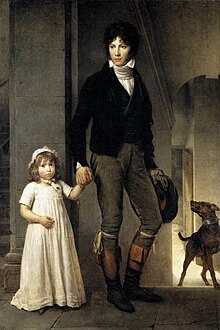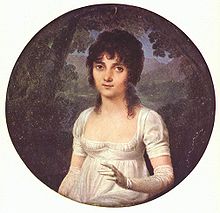

Jean-Baptiste Isabey (French pronunciation: [ʒɑ̃ batist izabɛ]; 11 April 1767 – 18 April 1855) was a French artist during both the First Empire and the Congress of Vienna.
Early life and education
Isabey was born in Nancy, France on 11 April 1767. At the age of 19, following some lessons from Francois Dumont, the miniature painter to Marie Antoinette, Isabey became a pupil of Jacques-Louis David.
Career
Isabey was hired by the Palace of Versailles to paint portraits of the dukes of Angoulême and Berry. He was commissioned by the queen, the first of several commissions he was awarded by successive French rulers until his death in 1855.
Patronized by Josephine and Napoleon Bonaparte, he arranged the ceremonies of their coronation and prepared drawings for the publication intended as its official commemoration, a work for which he was paid by Louis XVIII, whose portrait was engraved by Philibert-Louis Debucourt, was completed in 1814. Although Isabey did homage to Napoleon on his return from Elba, he continued to enjoy the favour of the Restoration, and took part in arrangements for the coronation of Charles X.
The July Monarchy conferred on him an important post in connection with the royal collections, and Napoleon III granted him a pension, and the cross of commander of the Legion of Honor. Review of Troops by the First Consul was one of his most important compositions.
Isabey's Boat, which was engraved by Charles Paul Landon, is a drawing of Isabey and his family. Produced at a time when Isabey was occupied with lithography, Boat was a great success at the Salon of 1820. His portrait, Napoleon at Malmaison, is considered his best, and his tiny head of the king of Rome, painted for a breast-pin, is distinguished by decision and breadth.
A biography of Isabey was published by Edmond Taigny in 1859. Charles Lenormant's article, written for Joseph-François Michaud's Biog. Univ., was based on facts furnished by Isabey's family.
His son, Eugène, also became a painter.
References
Sources
 This article incorporates text from a publication now in the public domain: Chisholm, Hugh, ed. (1911). "Isabey, Jean Baptiste". Encyclopædia Britannica. Vol. 14 (11th ed.). Cambridge University Press. p. 860.
This article incorporates text from a publication now in the public domain: Chisholm, Hugh, ed. (1911). "Isabey, Jean Baptiste". Encyclopædia Britannica. Vol. 14 (11th ed.). Cambridge University Press. p. 860.- Basily-Callimaki, Eva de, Mme, J.B. Isabey: sa vie, son temps, 1767-1855: Suivi du Catalogue de l'oeuvre gravee par et d'apres Isabey